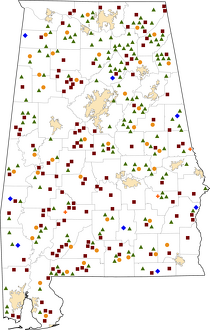Alabama
State Office of Rural Health
Alabama Office of Primary Care and Rural Health
Phone: 334.206.5396
view details
Alabama Nonmetro Population
5,054,253
Estimated population
1,118,392
(22.1%)
People living in nonmetro areas
Alabama Rural Healthcare Facilities
8
Critical Access Hospitals
3
Rural Emergency Hospitals
163
Rural Health Clinics
126
Federally Qualified Health Centers*
42
Short Term/PPS Hospitals*
*Sites according to data.HRSA.gov (July 2025), showing only locations outside of
U.S. Census
Bureau Urban Areas with a population of 50,000 or more
Last Updated: 9/11/2025
Last Reviewed: 7/31/2023



Selected Social Determinants of Health for Rural Alabama